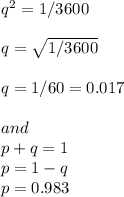
Tay–sachs disease is an autosomal recessive disorder. homozygous recessive individuals lack a key enzyme called hexosaminidase a, which presents as progressive mental and motor deterioration until death occurs around age 5. heterozygous individuals, called tay–sachs carriers, develop no symptoms of the disease. tay–sachs disease was historically more prevalent within populations of ashkenazi jews, pennsylvania dutch, southern louisiana cajuns, and eastern quebec french canadians. today, individuals descended from these populations are more likely to be tay–sachs carriers, but genetic testing within these populations has largely eliminated the occurrence of tay–sachs disease. for a randomly mating population, calculate the tay–sachs carrier frequency to three decimal points if 1 in 3600 individuals develops tay–sachs disease.

Answers: 2


Other questions on the subject: Biology

Biology, 20.06.2019 18:02, hayleyconsole
Why are there different theories about the effects of global warming
Answers: 2


Biology, 22.06.2019 05:20, kay3940
The large increase in atmospheric carbon dioxide in the last 50 years most likely comes from a. an increase in cellular respiration b. increased decomposition by bacteria c. an increase in the burning of fossil fuels d. an increase in photosynthesis
Answers: 3
You know the right answer?
Tay–sachs disease is an autosomal recessive disorder. homozygous recessive individuals lack a key en...
Questions in other subjects:





Mathematics, 03.08.2019 12:30

History, 03.08.2019 12:30

Mathematics, 03.08.2019 12:30

Mathematics, 03.08.2019 12:30






